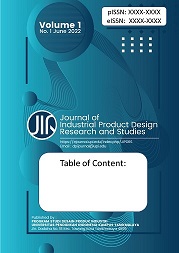A Product Development Model of Denim Jeans for The Indian Market
Abstract
Product development is an essential process in producing a marketable product. The study proposes a new product development model incorporating customer requirements and market trends for developing a new jeans range. The data on consumer preference of denim jeans was collected by employing a survey. The consumer survey provided insights into fit, colour, washing tone and style preference, wearing patterns, buying behaviour and sustainability requirements. Further, a web scraping algorithm was used to collect data on competitive online products. The features of jeans sold in the online market in India were studied. The data analysis provided the basis for feature selection for the denim jeans samples. These features provided the base for developing a new jeans range for men and women. Potential consumers wore the newly designed jeans, and feedback was collected. The method of competition mapping described in this study is economical and effective for forecasting trends. The proposed product development model has practical applications and is affordable for all brands.
Keywords
Full Text:
PDFReferences
Annapoorani S G.(2017). Introduction to denim. Sustainability in denim, Woodhead Publishing, 1-26.
Armstrong J S. (2001).Combining Forecasts. Armstrong J S (ed.) Principles of Forecasting: A Handbook for Researchers and Practitioners, Kluwer Academic Publishers, Norwell, MA.
Banerjee S and Banerjee M T. (2019). An Analytical Study on the Men’s Denim Wear Market in India–Identification of the Key Factors Influencing the Consumer Buying Behaviour in the Economy Segment. Amity Journal of Marketing, 4(1), 46-63
Clemen T. (1989). Combining forecasts: A review and annotated bibliography. International Journal of Forecasting, 5, 559-583.
Csanák, E. ( 2015). Denim Fitting & Finishing: Challenges on High-Quality. International Joint Conference on Environmental and Light Industry Technologies. Budapest, Hungary.
De Silva R K J and Rupasinghe T.(2016). Characterisation of new product development (NPD) models applicable to enhance the overall performance of the apparel industry. International Journal of Textile and Fashion Technology, 6(3), 1-14.
Fratto, G., Jones, M. and Cassill N. (2006). An investigation of competitive pricing among apparel retailers and brands. Journal of Fashion Marketing and Management, 10(4), 387- 404
Gaimster J. (2012). The changing landscape of fashion forecasting. International Journal of Fashion Design, Technology and Education, 5(3), 169-178.
Gu, X., Wong, Y., Peng, P., Shou, L., Chen, G., and Kankanhalli, M.S.(2017). Understanding fashion trends from street photos via neighbor-constrained embedding learning. In: Proceedings of the 25th ACM international conference on Multimedia, 190-198.
Gupta M, (2022). New Product Development Strategies and Methods: Implications for the Indian Readymade Apparel Sector, Aldieri L(ed.) Innovation, Research and Development and Capital Evaluation. IntechOpen, London.
Kaushik, V., Kumar, A., Gupta, H., and Dixit, G.(2020). Modelling and prioritising the factors for online apparel return using BWM approach. Electronic Commerce Research, 22, 843–873
Kuksov D. (2004). Buyer search costs and endogenous product design. Marketing Science, 23(4), 490-499.
Lee J H and Park S C. (2003). Agent and data mining based decision support system and its adaptation to a new customer-centric electronic commerce. Expert System with Applications, 25(4), 619–635.
Rahman O. (2011). Understanding Consumers' Perceptions and Behaviors: Implications for Denim Jeans Design. Journal of Textile and Apparel, Technology and Management, 7(1), 1-14.
Regan C. (2015). Role of denim and jeans in the fashion industry. Roshan P (ed.) Denim. Elsevier Ltd. 191-217.
Shi, M., Chussid, C., Yang, P., Jia, M., Lewis, V.D., and Cao, W.(2021). The exploration of artificial intelligence application in fashion trend forecasting. Textile Research Journal, 91, 19-20.
Taplin I. (2014). Global commodity chains and fast fashion: How the apparel industry continues to re-invent itself. Competition and Change, 18(3), 246-264.
Upadhyay D and Ambavale R. (2015). A study on preference with reference to denim jeans in female segment in Ahmedabad City. International Journal of Management and Social Science Research, 2(4), 153-159.
Wei Z and Zhou L. (2011). Case Study of Online Retailing Fast Fashion Industry. International Journal of e-Education, e-Business, e-Management and e-Learning, 1(3), 195-200.
Wong, M., Zhou, Y., and Xu, H. (2016). Big Data in Fashion Industry: Color Cycle Mining from Runway Data. 22nd Americas Conference on Information Systems – AMCIS 2016. San Deigo.
Yasim, A. M., and Tajuddin, R. M. (2020). Fabric, seam and design applications in developing body-contouring jeans for better size and fit. In: Zakaria N and Gupta D (eds.) Anthropometry, Apparel Sizing and Design, Woodhead Publishing, 203–216.
Yesil, E., Kaya, M., and Siradag, S. (2012). Fuzzy forecast combiner design for fast fashion demand forecasting. International Journal of Intelligent System Technology and Applications, 1-5.
Yu, Y., Hui, C. L., and Choi, T. M. (2012). An empirical study of intelligent expert systems on forecasting of fashion color trend. Expert Systems with Applications, 39(4), 4383-4389.
DOI: https://doi.org/10.17509/jipdrs.v2i1.55976
Refbacks
- There are currently no refbacks.
Copyright (c) 2023 Universitas Pendidikan Indonesia (UPI)

This work is licensed under a Creative Commons Attribution-ShareAlike 4.0 International License.

This work is licensed under a Creative Commons Attribution-ShareAlike 4.0 International License.



